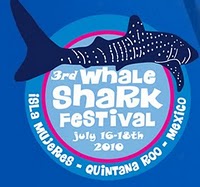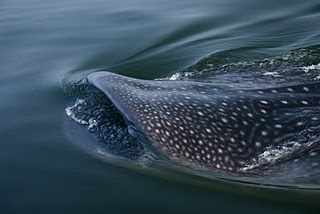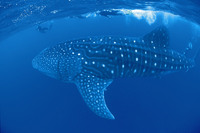Whale shark news roundup
 Tuesday, July 6, 2010 at 4:28PM
Tuesday, July 6, 2010 at 4:28PM 
There’s a heck of a lot going on in the world of whale sharks right now, so I thought a news roundup was in order.
Blogger GrrlScientist has a nice blog post up about whale sharks right now, over at Scientist Interrupted
Sad news about a whale shark that was trapped in fishing nets in Pakistan and died. I have no idea what the scientist is talking about when he describes them as “inefficient swimmers”; as far as we know they are paragons of efficiency. I also have my suspicions about whether this animal was actually dead when it was brought back to shore. In a different story about the same event, it described the animal as being alive when the fisherman found it, tail-looped it and dragged it back to the beach, and how its illegal to fish for them, but legal to use them as you like if they die accidentally, hmmm.... Without witnesses, I guess we'll never know.
Our collaborator Bob Hueter from the Shark Research Lab at Mote Marine Laboratory is following an animal dubbed Sara in the Gulf of Mexico, who has been affixed with a real-time satellite tag. So far she is avoiding the worst affected area of the BP oil spill, which is a relief. Follow her movements here.
Unfortunately, other whale sharks don’t appear to be avoiding the pollution. NOAA scientists last week observed whale sharks among ribbons of surface oil, not 4 miles from the Deepwater Horizon wellhead. If whale sharks are unable to avoid the oil, it’s a potential disaster because the anatomy of their gills and filter-feeding apparatus are superbly susceptible to fouling, as I discussed in a recent blog post.
One of my projects is getting a bit of press this week. Georgia Aquarium has entered into a collaboration with the Core Sequencing Facility at Emory University to start sequencing the genome of the whale shark. It’s a huge job, but the lab at Emory, led by Dr. Tim Read, are up to the task! They’re using Roche 454 pyrosequencers to generate a survey sequence right now, from DNA we isolated in the lab at the aquarium. Its exciting stuff and was picked up on the AP wire. Read an example here, or just google “whale shark genome emory”
University of Southern Mississippi research Eric Hoffmayer was lucky enough to observe an aggregation of about 100 whale sharks off the coast of Louisiana last week, accompanied by legendary marine explorer and Nat Geo guru Sylvia Earle. Eric has been working with that population for some time, but as far as I know thats the most he's ever seen in one place. Lets hope they are animals avoiding the oil spill.
And, finally, the 3rd annual Whale Shark Festival is scheduled to get underway in Isla Mujeres, Mexico, next Friday the 16th. I'll be there with other scientists including Bob Hueter and Rafael de la Parra, talking publically about whale sharks in the Gulf and the other amazing marine biology of the Yucatan. There's also going to be a film festival and cultural activities highlighting Quintana Roo. Did you know that "shark" is one of the only English words with a Yucatec Indian origin? Its comes from the Mayan "Xoc". Hope you can join us!
 Post a Comment |
Post a Comment |  Email Article | tagged
Email Article | tagged  BP,
BP,  Georgia Aquarium,
Georgia Aquarium,  Gulf of Mexico,
Gulf of Mexico,  Yucatan,
Yucatan,  mexico,
mexico,  whale sharks
whale sharks 









